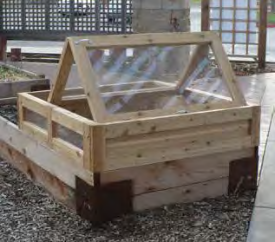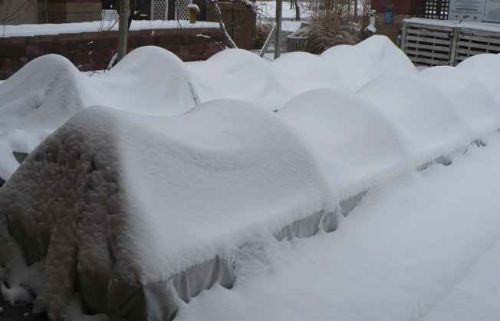Vegetable Season Extension

Last week felt more like August rather than late September with the high temperatures and lack of moisture. With the heat it’s hard to think about frost even though we are just a few weeks away from our 50/50 chance of having a nighttime temperature of 32 degrees. Despite the fact we are entering October, there is still some growing season left and there are ways to keep growing vegetables even beyond the first freeze. Let’s take a look at some options to extend your gardening season.
There are many ways to extend your vegetable growing season whether you are trying to grow later in the fall or start growing vegetables earlier in the spring. One of the easiest methods is to utilize floating row covers over the top of the plants similar to the photo to the right. Floating row covers are a spun-bonded polyester or polypropylene material fabric that comes in a variety of thicknesses depending on what you plan to use it for. You can use the fabric to create a low tunnel with hoops to hold the row cover over the top of the plants. Floating row covers will work to keep cool season crops warm during frosts including under snow however there are limits to how cold floating row covers can keep plants warm. This option works to keep the plants warmer and thinner fabrics can also used to exclude unwanted insects during the growing season.
 Cold frames are another option for extending the growing season both starting plants in the spring but also allows you to grow cold tolerant vegetables late into the winter season. Cold frames are typically low wooden boxes or frames with glass (often old storm windows), polycarbonate or polyethylene film covers, which are set in the soil or over beds in the garden. Cold frames are often constructed with a sloping top and set facing the south to capture the most winter sun. Tops may also be peaked or arched with hoops that support a polyethylene film covering. Polyethylene film is the same thing as plastic sheeting, but for applications such as cold frames and high tunnels, special greenhouse film is used, which is typically 6 mils thick and treated with a UV blocking material so that it will last at least four years.
Cold frames are another option for extending the growing season both starting plants in the spring but also allows you to grow cold tolerant vegetables late into the winter season. Cold frames are typically low wooden boxes or frames with glass (often old storm windows), polycarbonate or polyethylene film covers, which are set in the soil or over beds in the garden. Cold frames are often constructed with a sloping top and set facing the south to capture the most winter sun. Tops may also be peaked or arched with hoops that support a polyethylene film covering. Polyethylene film is the same thing as plastic sheeting, but for applications such as cold frames and high tunnels, special greenhouse film is used, which is typically 6 mils thick and treated with a UV blocking material so that it will last at least four years.
Low tunnels are hoop-supported row covers, too low to walk in. Tunnels high enough to walk in are called high tunnels. Low tunnels may be covered with polyethylene film or floating row cover and may vary in width to span a single row or one or more beds in the garden. Floating row covers of varying weights can be used during much of the year and can be replaced by polyethylene film during the winter. Lighter row cover can be used during the spring and summer, and heavier row cover can be used in the late and early winter for freeze protection. For covering in the winter, greenhouse polyethylene is preferred because it can be saved, and reused from year to year, but standard 6 mil polyethylene may be easier to obtain.

Fresh vegetables are a staple of many households and there are many ways to extend the growing season long past the first frost well into winter. Last winter I actually had a broccoli plant that survived all winter under leaves to be eaten in the spring. Try one of these season extension ideas this fall in your garden today.

Have questions? Contact our office where our Horticulture Extension Agent will assist you with questions.
Phone: (316) 321-9660
Email: callae@ksu.edu